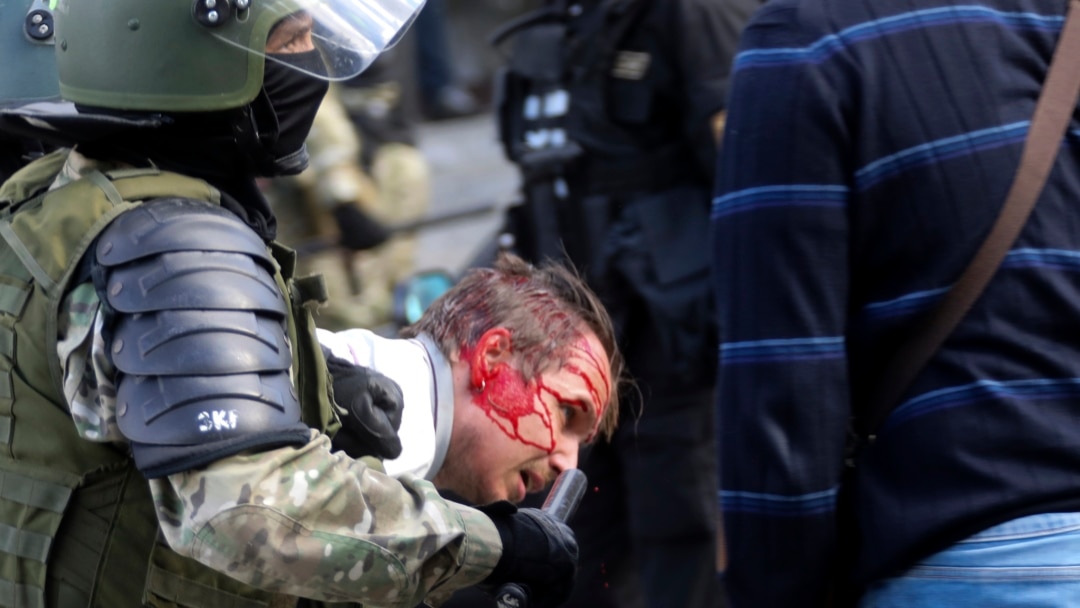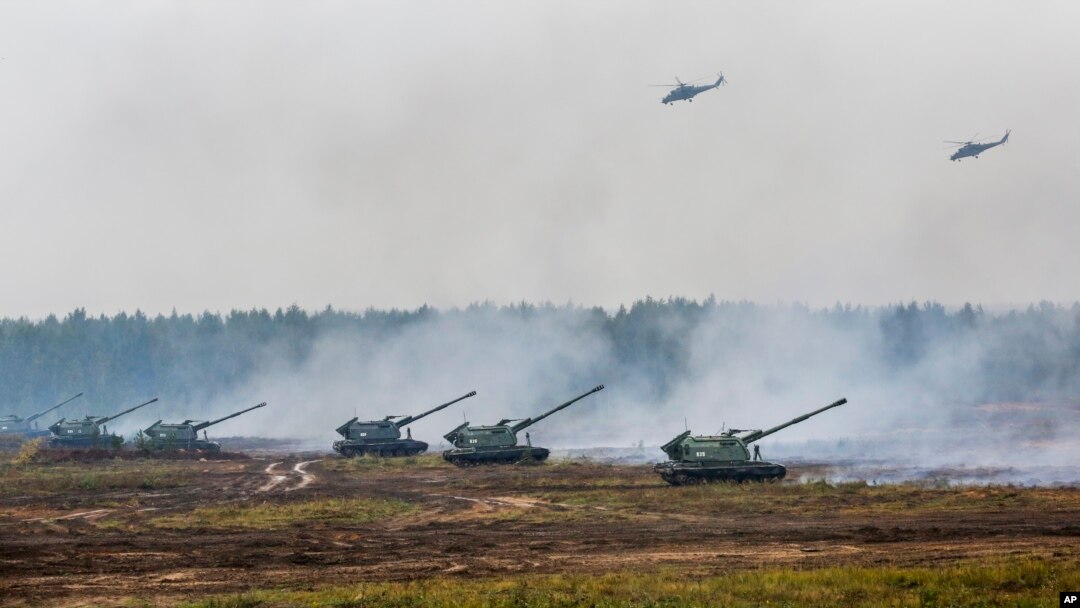Russia and Belarus will be the site of what could be the biggest military exercises in Europe in decades, which comes as Alyaksandr Lukashenka moves to integrate Belarus even closer not only militarily but politically with Russia, triggering fears he is bargaining away the country's sovereignty to its much bigger neighbor.
Zapad-2021, which held its opening ceremony on September 9 and will run until September 16, involves 200,000 military personnel and has raised alarms at NATO, which says the Kremlin has refused to invite observers as obligated under an international agreement. The Zapad maneuvers also follow a Russian military buildup on Ukraine's borders this year.
Belarus's neighbors are also wary, including fears of possible Russian electronic warfare (EW) directed at them during the exercises. Plus, Lithuania, Poland, and Latvia have all declared a state of emergency to contend with a surge of migrants they say Lukashenka is orchestrating to punish the European Union for putting sanctions on him, his inner circles, and businesses linked to him, in coordination with the United States, Britain, Canada, and other countries.
Crisis In Belarus

Read our coverage as Belarusian strongman Alyaksandr Lukashenka continues his brutal crackdown on NGOs, activists, and independent media following the August 2020 presidential election.
Belarus was plunged into turmoil in August 2020 when Lukashenka, in power since 1994, was declared the winner of a poll opponents and the West say was rigged. When tens of thousands of Belarusians took to the streets, Lukashenka reacted with a bloody crackdown. Tens of thousands have been detained, NGOs and independent media silenced, and opposition leaders jailed or forced to flee, including Svyatlana Tsikhanouskaya.
"The strategic situation today is very different than during the previous Zapad (or West) drill in 2017, given last year's protests and crackdown," said Robert Lee, a Russian military analyst.
"We know that Russia has wanted to expand its military footprint in Belarus, and this exercise may give us an indication of what Belarus would allow. It could also involve greater integration of Russian and Belarusian military and security services to put down a Color Revolution-type scenario in Belarus," Lee told RFE/RL in e-mailed comments.
Russia and Belarus are formally part of a "union state" and have been in talks for years to further integrate their countries. On the eve of the start of Zapad-2021, Lukashenka and Russian President Vladimir Putin were to meet in Moscow on September 9 with the union expected to top the agenda after weeks of reports and comments from Minsk and Moscow that negotiations were nearing an end.
What Is Zapad-2021?
In Belarus, five training centers in Brest, Baranavichy, Damanauski, Abuz-Lyasnouski, Ruzhanski, and the region of Hrodna, will be used for Zapad-2021, which takes place every four years. Many of the sites are located in western Belarus, near the border with Poland and Lithuania. In Russia, drills will take part at nine training centers, and the Northern Fleet will also be involved in the exercises.
As in 2017, the drills will focus on fictitious foes -- Nyaris, Pomoria, and the Polar Republic, this time -- as well as so-called terrorist organizations.
"This is an interesting development. While Nyaris appears to represent Lithuania and Pomoria is probably a stand-in for Poland, the Polar Republic is likely intended to represent Norway or another Scandinavian state, heralding a significant role in Zapad-2021 for Russia's Northern Fleet Joint Strategic Command," wrote Michael Kofman, a senior fellow at the Washington-based Center for a New American Security.
Jets take part in Zapad-2017.
The enemies may be fake, but the concerns the drills pose are real, especially for Belarus's neighbors. The pro-Kremlin newspaper Izvestia reported on August 11 that Zapad 2021 will witness one of the most expansive uses of electronic warfare in a Russian-led exercise, including EW units from Russia's 1st Tank Army and 20th Guards Combined Arms Army.
"Regarding EW, Russia's neighbors in Scandinavia and the Baltics have previously complained about GPS and other forms of jamming from Russia, which includes during the previous Zapad exercise. I expect this will be an issue near the Russian and Belarusian borders during this exercise as well. Given the state of NATO-Russian relations, I think Russia will be less concerned with angering its neighbors with EW," Lee wrote.
Lithuania, Latvia, as well as Poland are already contending with a surge in migrants whom the three countries and EU accuse of being directed to their borders by Lukashenka's government.
Belarusian Foreign Minister Uladzimer Makey last week dismissed the accusations and blamed "Western politicians" for the situation on the border.
"We do not expect a decrease in tensions on the eastern border because in a few days the biggest military exercises in 40 years will start, Zapad-2021," Polish Prime Minister Mateusz Morawiecki said on September 6.
The declared size of the drills is feeding regional fears. The Russian military has said Zapad-2021 will include 200,000 military personnel, including around 2,000 military personnel from the Moscow-led security pacts, the Collective Security Treaty Organization (CSTO), and the Shanghai Cooperation Organization (SCO). Armenia, Kazakhstan, Tajikistan, India, Kyrgyzstan, Mongolia, Serbia, and Sri Lanka were invited to send troops, but Serbia later said it would not take part. China, Vietnam, Burma, Pakistan, and Uzbekistan were sending observers.
If that figure turns out to be true, the Zapad-2021 military drills would be the biggest in Europe in decades. By contrast, 2018's Trident Juncture 18, NATO's largest exercise in a generation, involved merely 40,000 troops.
NATO said it had not been invited to observe the drills as spelled out by the Vienna Document, an international agreement governing military exercises in Europe.
"Currently, NATO has not been invited to send observers to Zapad-2021," NATO spokeswoman Oana Lungescu told RFE/RL. "Since the end of the Cold War, Russia has never opened an exercise for mandatory OSCE Vienna Document observation. This is despite the fact that observations are mandatory when exercises exceed 13,000 troops. We call on Russia and Belarus to act in a predictable and transparent way, in line with their international commitments. This is especially important when there is increased military activity along our borders, to reduce risks and avoid any accidents or incidents," Lungescu said in e-mailed comments on September 2.
According to a tally by the magazine NATO Review, Russia deployed between 60,000 and 70,000 troops in Zapad-2017 but only declared 12,700 personnel.
Belarus, Russia Beef Up Military Ties
Russia and Belarus began deploying forces and military hardware for the drills in late July, nearly two months before the start of Zapad-2021, "and far earlier than Russian forces have deployed for previous capstone exercises," according to the Washington-based Institute for the Study of War.
Russia has sent Sukhoi Su-30 fighter jets to western Belarus to a joint military training center that will fly joint missions and patrol the two countries' borders, the Belarusian Defense Ministry said on September 8.
On March 5, Belarusian Defense Minister Viktar Khrenin and Russian Defense Minister Sergei Shoigu announced plans to establish three permanent joint military-training centers in Russia's Nizhny Novgorod and Kaliningrad regions and in Belarus's western Hrodna region, which borders NATO members Poland and Lithuania. That came after the two countries' Defense Ministries signed a five-year strategic partnership agreement for the first time.
Establishing a joint military-training center in Hrodna is a clear indication Russia is looking to "expand its military presence in Belarus," Yahor Lebyadok, a Belarusian military analyst, told RFE/RL's Belarus Service on August 31.
The training center only makes sense, Lebyadok offered, if Belarus is also guaranteed Russia's advanced S-400 air-defense systems or Pantsir S1 surface-to-air missile systems.
Earlier this month, Lukashenka said Russia would soon deliver a huge military-hardware consignment to Belarus, including aircraft, helicopters, and air-defense systems.
In Belarus, Russia leases two military sites: a strategic ballistic-missile-defense site operated by Russian Aerospace Forces in Hantsavichy and the global communications facility for the Russian Navy in Vileyka.
Once wary of allowing Russia an air base on Belarusian territory, Lukashenka has been more eager to beef up ties as he faces growing international isolation.
Lukashenka said on July 30 -- the day after opposition leader Svyatlana Tsikhanouskaya met U.S. President Joe Biden at the White House -- that he was prepared to invite Russian troops into his country if such a move was necessary to ensure the security of both countries.
Russia may exploit Zapad-2021 to expand its military footprint in Belarus, stealthily leaving behind military hardware after the drills officially end on September 16, said Valeriy Akimenko, a defense analyst with the U.K.-based Conflict Research Center.
"Lukashenka's position is shaky, so this could be a concession to Russia to secure its support. In which case this may very well be the first step -- 'maskirovka' -- toward a permanent presence in Belarus, both to anger NATO and to tighten Russia's grip on Belarus," Akimenko said, referring to the Russian tactic of military deception.
"It is possible that some elements will stay. In fact, the likelihood is higher than four years ago," offered Konrad Muzyka, an independent defense analyst focusing on Russia and Belarus, as well as director of Rochan Consulting.
"What they [the Russians] are definitely using is the position Lukashenka put himself in," Muzyka added. "One can't really blame Moscow for trying to deepen the defense relationship when Belarus has no choice."


